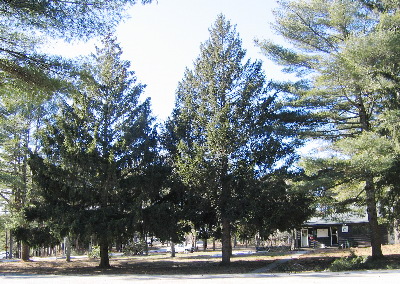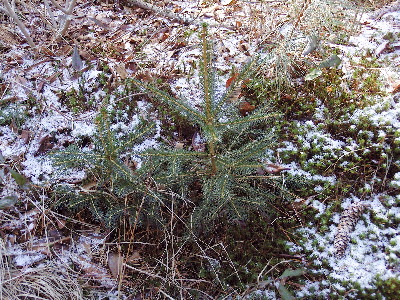Norway spruce:
Yet another invasive tree in New England
Alexey Zinovjev, Irina Kadis
Norway spruce (Picea abies) is an alien tree from Europe traditionally cultivated
in American cities and deliberately introduced to natural habitats.
According to the US Forest Service, it has been widely introduced to the Northeast, Pacific Coast, Rocky Mountain States,
as well as southeastern Canada. It is now fully naturalized in the eastern US from Connecticut to Michigan, including New England.
Around Boston, one can find old planted spruces literally at every reservation/park headquarters
as well as entire spruce plantations in parks. It has been expanding from these foreposts, successfully reproducing by seed, and
gradually displacing native plant communities.
Scattered young Norway spruces have recently become a common view in many reservations, for example, in Stony Brook Reservation.
In order to produce seed, Norway spruce needs full light, so cones are
usually found either high up on tops of tall spruces or at grove margins.
Seed are mostly dispersed during the wintertime, drifting with the wind,
in some instances capable of overcoming large distances across the
sturdy snow crust. However, more often seed don't drift that far—only
up to 60 m, according to some assessments.
The expansion of groves is a rather slow, inconspicuous process. Usually
young spruces form a continuous front around source trees. Spruce
seedlings and saplings are extremely shade tolerant, indeed shade
loving, thus capable of growing under a canopy of other trees. Over the
years, they become tall (up to 55 m = 180 ft), overgrowing and
displacing those trees that once gave them shelter.
As soon as Norway spruce takes over, very few plants can tolerate the newly formed habitat.
Because spruce foliage is very shade tolerant, each needle on a growing spruce branch survives for 4-5 years deep inside the crown
(as compared to only 2 years in sun-loving pines). Thus a very dense, shady canopy is formed in every spruce forest.
At the same time, the soil becomes highly acidic and devoid of nutrients in the surface horizon due
to a particular chemical process called leaching, which results in forming a special soil
type: podsol or spodosol.
It is mostly green mosses that can survive in the environment of
well developed Norway spruce stands. These are typical northern conifer forest (taiga) dominants--same
exact species that dominate Canadian as well as north European conifer forests, for example, Hylocomium splendens or
Pleurozium schreberi. No tree from Massachusetts known to us can share dominance with Norway spruce:
the spruce appears to always form single-species stands.
Because Norway spruce expansion is such a gradual process and also because young spruces
look so innocent and attractive, it is easy to underestimate the amount of damage this tree
inflicts on native American plants. Despite warnings and more and more evidence of Norway spruce's
aggressive nature, it is not yet included on the Invasive Plant List for New England.
-
U.S. National Parks where Norway spruce has been reported invasive:
Great Smoky Mountains National Park (North Carolina & Tennessee)
Haleakala National Park (Hawaii)
Monocacy National Battlefield Park (Maryland)
http://www.invasive.org/weedus/subject.html?sub=3386
- Norway spruce invasion in the alpine meadows of Central Europe:
Martin Dovčiak, Richard Hrivnák, Karol Ujházy and Dušan Gömöry. 2008.
Seed rain and environmental controls on invasion of Picea abies into
grassland. Plant Ecology. 194 (1): 135-148 Abstract at:
http://www.springerlink.com/content/x45765p741653508/
Alexey Zinovjev, Irina Kadis
1 February 2010
|

